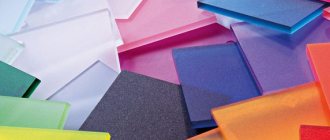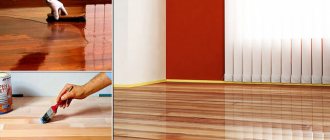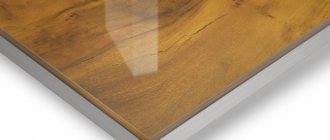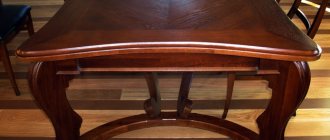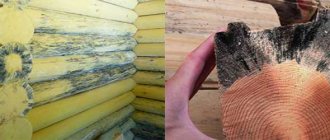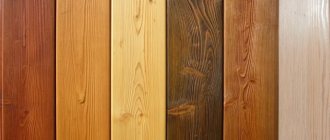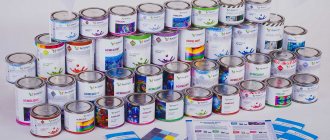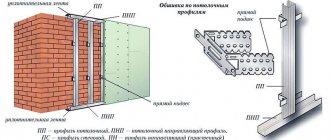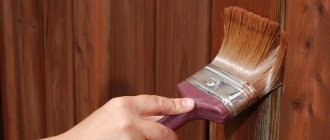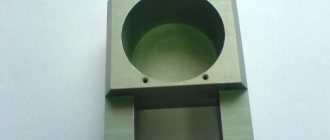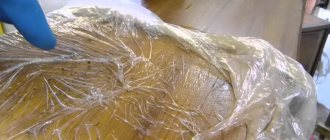Choosing a wood varnish
Wood varnishes are not universal products. Preparation should be adapted to the type of wood, the extent of surface use and its location. Which wood varnish should you choose for an attractive, long-lasting finish?
The main selection criterion should be the place where the product is used. Manufacturers offer health-safe, quick-drying and easy-to-use varnishes for indoor use, as well as weather-resistant and biocorrosion-resistant varnishes for outdoor use. Equally important is the type of surface to be painted. To impregnate a wooden shelf or tray, ordinary acrylic varnishes (water) are sufficient. Floors, parquet or stairs require effective protection against abrasion and mechanical damage. Therefore, you should use a professional product designed for this type of surface.
Wood varnishes provide a variety of finishes. On the market you can find preparations that form a matte, semi-matte, satin or glossy finish. It is worth remembering that wood that is painted to a high shine looks very impressive, but it is easier to scratch. Varnishes can expose the natural color and grain of the material or give it a subtle color. In addition to clear products, there are also products with added pigment that allow you to paint the wood white or significantly darken the surface.
Safety regulations
Regardless of the choice of material, when processing wood you need to follow some recommendations. This will allow you to perform the varnishing properly without harming your health.
Basic Rules:
- The rooms in which the material is applied must be equipped with a good ventilation system and illuminated with natural light. In such conditions, there is a high probability of doing the work efficiently and completely safe for health.
- Particular care should be taken when varnishing outdoor surfaces: dust contaminants may get onto the surface being treated. Also, avoid excessive exposure to sunlight. This may cause a decrease in the quality of the work done.
- When applying varnish, you must adhere to the permissible temperature conditions. According to the instructions, for most materials, when varnishing, the temperature in the room and environment should not be lower than +5°C. After treating the wooden base, it is unacceptable to speed up its drying. This will most likely provoke a violation of technology. If the temperature requirements are not met, bubbles and other undesirable defects often appear on the treated surface.
- All types of paint and varnish work are carried out wearing a mask, goggles, gloves, and a protective suit.
Attention! Most varnishes, especially those with a solvent, are characterized by an unpleasant, pungent odor. Therefore, it is extremely important to provide reliable protection for the respiratory system, and therefore maintain your health.
For safety, surface treatment with varnish should be performed in a special protective suit Source parketista.ru
Selecting Tools
In order for wood varnishing to occur correctly, it is necessary to use the appropriate tools. The roller ensures fast and even distribution of paint, so it is worth using for painting large, smooth surfaces, for example, in the case of painting the surface of a car, facade boards, floors or wardrobe doors. Brushes are used for varnishing small parts of complex shapes. They are ideal for work requiring high precision.
Excellent results, regardless of the type of surface, are ensured by a properly used spray gun. With this tool you will get a perfectly smooth coating with uniform thickness. Unfortunately, painting wood with a spray gun is not as effective as painting with a brush or roller. When using this method, be aware of the need for more paint wear, especially if the wood surface has irregular shapes or holes.
When purchasing a brush or roller, consider the type of paint you plan to apply. Solvent-based preparations should be applied with a natural bristle brush (pigskin or horsehair) or a roller with short, thick, solvent-resistant fleece (such as velor-lined). Water-based varnishes can be applied using an artificial bristle brush or a roller for smooth surfaces with short synthetic fleece.
The workplace must be properly protected, so a protective film is required. In addition, you should prepare small, medium and large sanding paper, a sanding machine (optional), protective clothing and gloves (if the product contains substances harmful to health), a drawing tray, a clean cloth and a vacuum cleaner.
What composition should I use?
The choice of varnishes is huge. The compositions are classified into several groups according to the type of base. To choose a paint coating, use the following tips:
A good option is varnish for interior work.
If there is high humidity in the room, then it is better to choose paints and varnishes for outdoor use. Pay attention to resistance to sudden temperature fluctuations. Consider the interior style. For example, matte varnish is suitable for Provence style rooms. Surface quality
When varnishing interior doors, gloss will make defects and unevenness more visible, while matte will disguise it.
Attention It is necessary to check the selected composition for compatibility with the primer. Otherwise, a combination of inharmonious materials will lead to cracking or final damage to the canvas. Next, popular paints and varnishes, their advantages, features and disadvantages will be considered
Which varnish to choose is up to the individual to decide, based on personal wishes and financial capabilities.
Next, popular paints and varnishes, their advantages, features and disadvantages will be considered. Which varnish to choose is decided by the person himself, based on personal wishes and financial capabilities.
Alkyd
The varnishes are made with solvents; interior doors will have an off-white, rather yellowish tint.
Advantages:
- strength;
- moisture resistance;
- quick drying;
- acceptable price.
Minuses:
- unpleasant pungent odor;
- rapid fading in the sun;
- contains harmful substances.
Nitrovarnishes
Acetone and nitrogen compounds act as a base. The substance is transparent and can preserve the natural shade of wood. However, nitro varnish cannot be used in living rooms.
Pros:
- low price;
- strength;
- durability;
- short drying time - up to 1 hour.
Flaws:
- toxicity;
- flammability.
Important: It is prohibited to use this composition in homes where children and pets live.
Polyurethane
The basis is polymers with long molecules. When coated, this varnish changes the shade of interior doors to a darker one.
Advantages:
- nice smell;
- no toxicity.
But polyurethane varnish is applied only to a previously prepared primer layer.
Acrylic
Manufactured on a water basis. Eco-friendly, suitable for use in living rooms.
Pros:
- quick drying due to water evaporation;
- resistance to sunlight;
- mechanical damage.
Disadvantages - fragility.
How to sand wood
Before applying paint, carefully prepare the substrate. The wood must be clean, dry and smooth. In case of repair of elements, old paint and varnish coatings must be removed. Wash greasy or tar-covered areas with solvent and then dry.
To obtain a perfectly smooth surface, the wood must be carefully sanded with sanding paper or a sander. The paper granulation should be adjusted depending on the type of substrate and the degree of unevenness of the substrate. Sanding is done in stages: first, level the wood with the thickest paper (gradation approx. 80 - 100), then medium (approx. 120 - 140) and finally thin (approx. 180 - 200).
Wood surface primer
At the manufacturer's request, before painting, pre-treat with diluted varnish or a special primer for wood. Thanks to this treatment, the top layer of varnish adheres better to the base. The primer layer will also provide effective protection of the raw material from moisture, reduce the absorbency of the wood and prevent its darkening. All necessary information about surface preparation must be included in the technical data sheet of the product.
Attention! Wood that has been pre-oiled cannot be painted. In the case of exotic species, it is necessary to use a special cutting primer, which neutralizes the effect of oily substances contained in the wood.
Applying the first layer of varnish to wood
Before applying the first coat of paint, make sure that the working environment is favorable: Optimum temperature (15 to 20 °C) and air humidity (approx. 50-65%).
If you are doing the procedure outside, plan to paint on a sunny, windless day. Wood must be protected from precipitation during painting and drying. By following the above recommendations, you will protect the varnished surface from dirt (for example, pollen) and provide it with appropriate conditions for drying.
How to varnish wood to obtain a uniform, smooth coating of uniform thickness? Products should be applied in thin layers, guiding the brush or roller along the grain. It's best to start in hard-to-reach areas, such as depressions or joints between two elements. After applying the first coat of varnish, leave the painted surface to dry completely.
Drying time for the coating is approximately 4 hours for acrylic products and approximately 10-12 hours for solvent-based products intended for external use.
Reapplying paint
To obtain a durable varnish coating, at least two layers of varnish must be applied. In the case of intensively used surfaces (chair seat, table, etc.) subject to abrasion and mechanical damage, 3 or 4 layers can be applied. Make sure there are no contraindications in the product data sheet.
Before applying the next coat of varnish, sand the surface with high-grit sandpaper and then wipe the surface with a vacuum cleaner or damp cloth. This way you can smooth out raised wood fibers and get a perfect, even finish. Then apply a second coat of varnish and let it dry.
Attention! The varnish is completely cured only after a certain time (from approximately 24 hours to 2 weeks). Before the coating reaches full strength, it is necessary to limit use of the painted surface and protect it from damage such as staining or scratching.
Recommendations
After each grinding operation, the surface should be carefully removed from the effects of grinding. You can use a vacuum cleaner and then remove the smallest particles with a damp cloth.
Depending on the desired result and financial capabilities, several layers of varnish are applied. As a rule, they are limited to three layers, but 5-7 layers are possible.
All layers, except the finishing one, are applied with a perpendicular overlap of each layer. Even chaotic movement with a brush or roller is allowed, as long as the varnish is evenly distributed over the surface. As for the last finishing layer, here the movements should be directed from the light source deep into the room.
After applying all layers, the floor is left in this state until the varnish is completely dry. In this case, it is necessary to ensure that dust and dirt cannot enter the room.
After the period indicated on the packaging, you should check the floor for quality of painting. If it gets a little sticky, you can wash it with a mild soap solution or dishwashing detergent.
Despite this, full mechanical loads on the floor will be possible no earlier than in a week. After this time, the floor will be reliably protected from various external factors. At the same time, the attractive appearance of the wood will be preserved.
But this does not mean that you cannot do the same thing yourself, especially since it will cost much less. If you are not very picky and have a philosophical attitude towards everything, then you can varnish the floors with your own hands. The main thing is to strictly follow the technology, moving from one technological operation to another
Having a special tool is of no small importance.
If you plan to varnish one room, then you won’t need any special tools other than a hand sander. The main condition is the absence of haste, then everything will work out. This is especially true for such a technological operation as varnishing
It is very important that during these stages, each layer dries completely.
Washing tools
After completing the work (and between subsequent coats of paint), be sure to thoroughly clean the tool. Dirt from chemical varnish can be removed with an oil-phthalic solvent. Tools coated with acrylic varnish can be cleaned with water.
Wood protected with varnish does not require regular maintenance. It is also very easy to care for. To keep the surface in good condition, simply wash it with a damp cloth. However, beware of sharp objects that can scratch the coating. Damage to the varnish layer can significantly weaken its protective and aesthetic properties.

